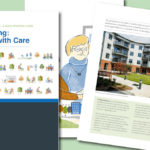One in four people in the UK will be aged over 65 by 2037; it is estimated there will be a shortfall of almost 70,000 homes with care in the next decade. The new guide by the Urban Land Institute offers guidance for investors, developers and architects on how to best design, build and operate housing with care, part of the later living sector.
Driven by long-term demographic changes and a chance to invest responsibly, billions of pounds from insurers and pension funds are set to pour into the UK’s emerging housing with care sector, according to the Later Living: Housing with Care guide, published today by the Urban Land Institute (ULI).
Institutional backing of housing with care could move the sector from being predominantly sales-led to an operational long-term income model, with a focus on the quality of management and provision of services and amenities, according to the guide.
The UK’s rapidly ageing population, with one in four Britons predicted to be 65 or over by 2037, is creating a clear need for more significant provision of housing with care for older generations, which could alleviate pressure on public services like the NHS.
Research shows those living in properties with provided care run by the ExtraCare Charitable Trust, saves the NHS £1,994 per person on average over five years, reducing NHS spending for residents by nearly two fifths.
Best practice advice
The ULI guide sets out best practice and innovation within this emerging sector for funders, developers, architects, and operators.
Given that these developments will be housing the elderly, providing quality care facilities alongside other amenities will be crucial. Professional operations and management will be essential, such as the provision of staff and 24-hour care, allowing residents to maintain their independence for longer.
Changing tastes among the elderly will have to be catered for as well, with the baby boomer generation wanting to pursue an active and fulfilled lifestyle in old age. Combining good design principles with activities, enlivening initiatives and staff training is vital to creating aspirational places to live in environments where residents feel happy and supported.
The report also outlines that precise legislation and planning guidelines that apply specifically to organisations that build and operate housing with care developments will be needed to meet the demand of an ageing population.
As it stands, the patchwork of legislation governing the sector poses challenges. It creates a complicated process for housing with care operators to achieve planning and deliver the quality of homes and care needed.
Sector-specific legislation and regulation will provide a more straightforward and more stable set of rules, which both increase consumer confidence and provide much-needed clarity and consistency for operators, funders and other stakeholders.
Despite the lack of legislation, the UK has the added advantage of a blank canvas to develop a thriving later living sector akin to the mature markets overseas.
Through a combination of more precise legislation, planning guidelines, good design and well-managed operations, housing with care has the potential to be a fast-growing asset class following the success of Build To Rent and student accommodation.
The full findings of the report can be found here.
Not enough suitable accommodation
Vanessa Hale, UK Chair of the ULI and Director of Research at BNP Paribas, said: “The great advancements in technology and medicine have resulted in the UK population living longer. The unfortunate aspect is that we are stretching the NHS and have not built enough suitable accommodation for us to comfortably age into. However, through better quality housing with integrated care services, our massively expanding senior population can have an attractive variety of options enabling them to thrive during their later years.”
Stephanie McMahon, Head of Research at BNP Paribas Real Estate UK, said: “There’s a clear need to provide more housing with care to cater for the UK’s rapidly aging population. Providing homes that older generations can aspire to move into may encourage more people to downsize, while the provision of onsite care may alleviate the very real pressures on the healthcare services. Our aspiration is to encourage conversations within the industry about what is needed to promote new and emerging models that will attract new entrants, funders and operators, and inform strategic planning across a diverse spectrum of stakeholders.”
Russell Pedley, Chair of ULI UK Residential Council and Co-Founder of Assael Architecture, said: “There’s a genuine chance for the UK to develop a world-leading Later Living sector. Bringing together design, care and services seamlessly will be fundamental in providing homes that older people want to live in. For example, making sure there are amenities and facilities that are inter-generational such as retail, or developing sites on high streets to exploit the central, amenity-laden locations of our high streets, could help these developments foster a real sense of community across the generations. This guide is providing a clear path for designers to develop that best practice for this new and emerging asset class.”
Jamie Bunce, CEO, Inspired Villages, commented: “As an operator and developer of later living communities across the UK we take a long-term view of this emerging sector; if we look to the next 20-30 years little is more certain than the growth of Britain’s elderly population. Targeted care that deals with real physical, medical, social and financial needs, while providing the freedom and independence we would want for our own parents is vital to delivering to the growing demand. And there is clear potential for this to make massive savings to the NHS. This is why we, together with our partners Legal & General, need focused policy change that recognises the need for later living within planning guidance. We are passionate about making it simpler to invest in one of the most chronically underserved sectors in society.”
Kevin Beirne, Director, Head of Retirement, Octopus Real Estate, said: “We know from our research that older people don’t want to live in isolated retirement ‘ghettos’ away from local amenities — but the challenge of providing enough onsite facilities makes it hard to find the right sites as there is no firm policy support in favour of senior living.
“What’s clear, is the demand is only set to increase and with growing pressure on health and social care, there is a strong economic case for creating high quality developments that fulfil both consumer demands and appetite from investors for diversified, defensive assets that blend residential and healthcare.”
Andrew Ovey, Head of Healthcare, AXA IM, Real Assets, commented: “While Housing with Care is demographically supported by the UK’s aging population, it’s the asset class’s ability to deliver long-term, sustainable income whilst simultaneously making a positive contribution to local communities that makes it particularly attractive to institutional investors. AXA IM – Real Assets’ acquisition, on behalf of clients, of Retirement Villages Group in 2017 provided us with a platform to grow in this space and, against a backdrop of constrained supply and increasing demands on public spending, I expect more institutions to follow over the coming years.”
Quality homes for older people
Baroness Sally Greengross, President and Chief Executive, International Longevity Centre UK said: “The issue of quality homes for older people as well as quality care is personal. I saw the lack of options available to my mother, as she grew frailer. But she was one of the fortunate ones because she was able to move to a housing with care development in Brighton, providing her with the support she needed which enabled her to retain her independence.”
Nick Sanderson, Founder & CEO, Audley Group, added: “There’s a real need to frame the professional later living sector against many of the offerings consumers may mistake it for. This isn’t about building old school care homes nor is it about simply employing a gardener and pretending it’s “care”. What we are focused on creating are aspirational places where people want to live.”
Jeremy Porteus, Chief Executive, Housing Learning and Improvement Network, said: “Housing with care brings together real estate and operation, delivering the potential for long term investment and solid returns, while at the same time providing sustainable services to our retirees. It is a modern solution to the modern phenomenon of longevity, and there is a huge market.”
Debra Yuddolph, Partner, SAY Property Consulting, said: “How the property will operate must be considered in the initial design stage, alongside the careful planning of the governance or legal structure, to ensure long-term, effective stewardship is achieved. If the professional management of housing with care is executed well then we can achieve high-quality places, long-term demand, enhanced company legacy and a supportive environment for residents.”
Phil Schmid, Director in Living Capital Markets – Healthcare, JLL, said: “There are a variety of tenures that can be used to harness the potential of the housing with care market but what is critically important is flexibility for the operator to match the tenure to the market, which may also mean taking a mixed tenure approach. We need to create opportunities for increased provision and supply to the consumer and unlock investment from a wider range of organisations.”
Sara Livadeas, Chief Executive, The Fremantle Trust, said: “Delivering housing with care is a skilled activity that requires a thorough understanding of policy, regulation, definitions and key principles, and consumer wellbeing. People will expect a home for life so the design, facilities and employees have to work together to create an environment for healthy ageing, with care acting as an enabler, to differentiate between a registered care home and housing with care.”









